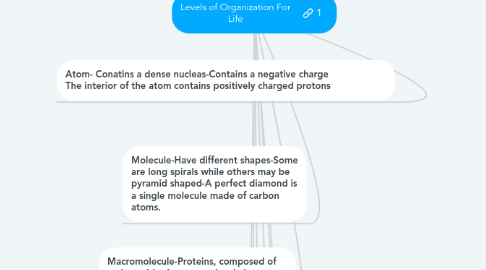Levels of Organization For Life
by Payton Parsons

1. Macromolecule-Proteins, composed of amino acids.-A macromolecule is a very large molecule, such as protein, commonly created by the polymerization of smaller subunits.-The most common macromolecules in biochemistry are biopolymers and large non-polymeric molecules
2. Organs- are essential for survival. - These are the brain, heart, kidneys, liver and lungs.-The human brain is the body's control center, receiving and sending signals to other organs through the nervous system and through secreted hormones.
3. Organelles- intracellular membrane-bound structures.- lysosomes
4. Cells-he basic building blocks of living things. -The human body is composed of trillions of cells, all with their own specialised function. -Cells provide structure for the body, take in nutrients from food and carry out important functions.
5. Tissue- usually made of cells and extracellular fibers that hold structures together (tendons), protect them (cartilage), store energy (fat), or produce blood.-Muscular tissue is made of cells that are organized to shorten and produce force when they contract (smooth skeletal and cordine muscle).
6. Molecule-Have different shapes-Some are long spirals while others may be pyramid shaped-A perfect diamond is a single molecule made of carbon atoms.
7. Atom- Conatins a dense nucleas-Contains a negative charge The interior of the atom contains positively charged protons
8. Organ System-Some organs are called hollow organs because they have an empty tube or pouch.-Other organ systems in the human body include the immune system and the lymphatic system.- Examples of hollow organs include the stomach, intestine, and the heart. The eye is an organ that is generally considered part of the nervous system.
8.1. ism
9. Organism-Organisms can be made up of just one cell. -They are called unicellular organisms or single celled organisms. -Examples include bacteria, and protozoa such as the Amoeba and Paramecium.


